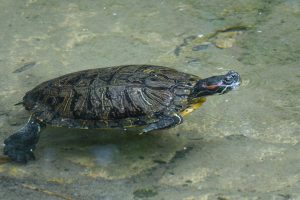August 2019.
 With the arrival of August’s 100-degree days, and little rain in the forecast, the possibility of a dry spell for the creek and its inhabitants increases daily.
With the arrival of August’s 100-degree days, and little rain in the forecast, the possibility of a dry spell for the creek and its inhabitants increases daily.
Re-watching the Fresh Water episode from BBC’s original Planet Earth series (episode 3, 2006) can be refreshing, and also offers a conservationist perspective for our own small part of the watershed. It’s well worth a relook – in the opening minutes, the narrator, David Attenborough, presents two striking facts:
- Only 3% of the world’s water supply is fresh water. All life on land is ultimately dependent on fresh water.
- Of this small share, much is locked in the polar ice caps, deep underground, or severely polluted. Thus the amount of drinkable water available to all humans is only 0.4 %. Four-tenths of one percent of all water.
Thanks to our Master Naturalist and Creek Leader, Gary Barton, for this reference: What is the Percentage of Drinkable Water on Earth?
Such global considerations certainly merit our interest, and we need look no further than our own Joe’s Creek – the perennial habitat for turtles and toads, waterfowl and dragon flies – to appreciate the importance of protecting water quality by minimizing use of fertilizers, and avoiding inorganic pesticides. Contaminants that enter urban creeks and streams can remain in the watershed, untreated, all the way to the ocean.
The red eared slider shown above seemed to enjoy the clear waters of the creek in April. Let’s work to keep it that way.
Vince Punaro, for the creek leaders